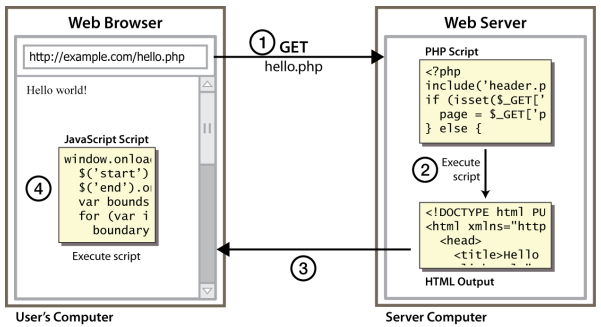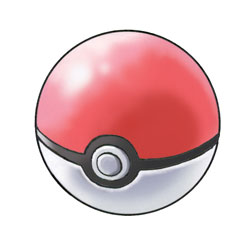Lecture 6
Introduction to JavaScript
Course Logistics
HW 2 is out (layouts and flexboxes): Due Wednesday (October 11th)
Part 2 of the Creative Project is due tonight. I have office hours in CSE 216 right after lecture! Great work so far :)
What We've Learned So Far
How to write content for a webpage using HTML
How to add styles to a webpage using CSS and linking a CSS file to an
HTML file
How to inspect the HTML and CSS of web pages in the browser
Today: JavaScript
Now that we know how to add content and styles to a web page, let's explore how to add responsive behavior
This lecture we'll cover the basics of the JavaScript language:
- JavaScript vs. Java comparisons
- Syntax and types
- Loops and functions
- Events (basics) and form elements
Later this week we'll use these building blocks to learn how to dynamically update what you see on a web page in response to clicks, text input, timers, etc.
Terminology: Client-Side Scripting

Client-side script: Code runs in browser after page is sent back from server. Often, this code manipulates the page or responds to user actions.
What is JavaScript?
A lightweight programming language ("scripting language")
Created in 1995 (over 10 days) by Brendan Elch (originally called Mocha then LiveScript)
Used to make web pages interactive:
- Insert dynamic text into HTML (ex: username)
- React to events (ex: page load, user's mouse click)
- Get information about a user's computer (ex: what browser they are using)
- Perform calculations on user's computer (ex: form validation)
A web standard (but not supported identically by all browsers)
NOT related to Java other than name and some syntactic similarities...
Can be used in the browser, Adobe Acrobat, Adobe Photoshop, embedded computers, the Unix terminal, etc. (we will be using it in the browser)
JavaScript vs. Java

Interpreted, not compiled (huh?)
More relaxed syntax and rules
- Fewer and "looser" data types
- Variables don't need to be declared
- Errors often silent (few exceptions)
JavaScript's key construct is the function rather than the object/class.
- "first-class" functions are used in many situations
Contained within a web page and integrates with its HTML/CSS content
Linking to a JavaScript file: <script>
HTML (template)
HTML (example)
The script tag should be placed in the HTML page's
head
Script code is stored in a separate .js file
JS code can be placed directly in the HTML file's body or head (like CSS)
- This is bad style though: You should always separate content, presentation, and behavior
Our First JavaScript Statement: alert
alert("message");
JS (template)
alert("IE6 detected. Suck-mode enabled.");
JS (example)

A JS command that pops up a dialog box with a message
Variables and types
let name = expression;
JS (template)
let level = 23;
let accuracyRate = 0.99;
let name = "Pikachu";
JS (example)
Variables are declared with the let keyword (case-sensitive). You may also see var used instead of let - this is an older convention, and you should use let in this class.
Types are not specified, but JS does have types ("loosely-typed")
Number,Boolean,String,Array,Object,Function,Null,Undefined- Can find out a variable's type by calling typeof
- Note: Type conversion isn't always what you expect...
Number type
let enrollment = 99;
let mediangrade = 2.8;
let credits = 5 + 4 + (2 * 3);
JS
Integers and real numbers are the same type (no int vs. double)
Same operators: + - * / % ++ -- = += -= *= /= %=
Similar precedence to Java
Many operators auto-convert types: "2" * 3 is 6
String type
let nickName = "Sparky O'Sparkz"; // "Sparky O'Sparks"
let fName = nickName.substring(0, s.indexOf(" ")); // "Sparky"
let len = nickName.length; // 15
let name = 'Pikachu'; // can use " " or ' '
JS
Methods:
charAt,
charCodeAt,
fromCharCode,
indexOf,
lastIndexOf,
replace,
split,
substring,
toLowerCase,
toUpperCase
charAtreturns a one-letterString(there is nochartype)
length is a property (not a method, as it is in Java)
Concatenation with +: 1 + 1 is 2, but "1" + 1
is "11"
Practice: repeat, containsTwice
More about Strings
Escape sequences behave as in Java: \' \" \& \n \t \\
To convert between numbers and Strings:
let count = 10; // 10
let stringedCount = "" + count; // "10"
let puppyCount = count + " puppies, yay!"; // "10 puppies, yay!"
let magicNum = parseInt("42 is the answer"); // 42
let mystery = parseFloat("Am I a number?"); // NaN
JS
To access characters of a String s, use s[index] or
s.charAt(index):
let firstLetter = puppyCount[0]; // "1"
let fourthLetter = puppyCount.charAt(3); // "p"
let lastLetter = puppyCount.charAt(puppyCount.length - 1); // "!"
JS
Comments (same as Java)
// single-line comment
/* multi-line comment */
JS
Identical to Java's comment syntax
Recall: 3 comment syntaxes
HTML: <!-- comment -->CSS/Java/JS: /* comment */Java/JS: // comment
Practice:
commentSyntax,
commentary
for loop (same as Java)
for (initialization; condition; update) {
statements;
}
JS (template)
let sum = 0;
for (let i = 0; i < 100; i++) {
sum = sum + i; // same as sum += i;
}
JS (example)
let s1 = "It's a-me, Mario!";
let s2 = "";
for (let i = 0; i < s.length; i++) {
s2 += s1[i] + s1[i];
}
// s2 stores "IItt''ss aa--mmee,, MMaarriioo!!"
JS (example)
Math object
let rand1to10 = Math.floor(Math.random() * 10 + 1);
let three = Math.floor(Math.PI);
JS
Methods: abs,
ceil,
cos,
floor,
log,
max,
min,
pow,
random,
round,
sin,
sqrt,
tan
Properties: E, PI
Logical Operators
Relational: > < >= <=
Logical: && || !
Equality: == != === !==
- Most logical operators automatically convert types. These are all true:
5 < "7"42 == 42.0"5.0" == 5
- The
===and!==are strict equality tests; checks both type and value:"5.0" === 5isfalse
Boolean Type
let iLikeJS = true;
let ieIsGood = "IE6" > 0; // false
if ("web dev is great") { /* true */ }
if (0) { /* false */ }
JS
Any value can be used as a Boolean
- "falsey" values:
0,0.0,NaN,"",null, andundefined - "truthy" values: anything else
Converting a value into a Boolean explicitly:
let boolValue = Boolean(otherValue);let boolValue = !!(otherValue);
Special Values: null and undefined
let foo = null;
let bar = 9;
let baz;
/* At this point in the code,
* foo is null
* bar is 9
* baz is undefined
*/
JS
undefined: has not been declared, does not exist
null: exists, but was specifically assigned an empty or null
value
Why does JavaScript have both of these?
if/else Statements (same as Java)
if (condition) {
statements;
} else if (condition) {
statements;
} else {
statements;
}
JS
Identical structure to Java's if/else statements
JavaScript allows almost anything as a condition
Practice:
rockPaperScissors
while loops (same as Java)
while (condition) {
statements;
}
JS
do {
statements;
} while (condition);
JS
break and continue keywords also behave as in Java but do not
use them in this class!
Practice:
loopMystery6
Arrays
let name = []; // empty array
let names = [value, value, ..., value]; // pre-filled
names[index] = value; // store element
JS (template)
let types = ["Electric", "Water", "Fire"];
let pokemon = []; // []
pokemon[0] = "Pikachu"; // ["Pikachu"]
pokemon[1] = "Squirtle"; // ["Pikachu", "Sqiurtle"]
pokemon[3] = "Magikarp"; // ["Pikachu", "Sqiurtle", undefined, "Magikarp"]
pokemon[3] = "Gyarados"; // ["Pikachu", "Sqiurtle", undefined, "Gyarados"]
JS (example)
Two ways to initialize an array
length property (grows as needed when elements are added)
Array methods
let a = ["Mario", "Luigi"]; // [Mario, Luigi]
a.push("Koopatroopa"); // [Mario, Luigi, Koopatroopa]
a.unshift("Bowser"); // [Bowser, Mario, Luigi, Koopatroopa]
a.pop(); // [Bowser, Mario, Luigi]
a.shift(); // [Mario, Luigi]
a.sort(); // [Luigi, Mario]
JS
Array serves as many data structures: list, queue, stack, ...
Methods: concat,
join,
pop,
push,
reverse,
shift,
slice,
sort,
splice,
toString,
unshift
pushandpopadd/remove from backshiftandunshiftadd/remove from frontshiftandpopreturn the element that is removed
Practice:
findMin
,
switchPairs
Splitting strings: split and join
let s = "the quick brown fox";
let a = s.split(" "); // ["the", "quick", "brown", "fox"]
a.reverse(); // ["fox", "brown", "quick", "the"]
s = a.join("!"); // "fox!brown!quick!the"
JS
split breaks apart a String into an array using a delimiter
- Can also be used with regular expressions surrounded by /:
let a = s.split(/[ \t]+/);
join merges an array into a single String, placing a delimiter between
them
Defining functions
function name() {
statement;
statement;
...
statement;
}
JS (template)
function myFunction() {
alert("Hello!");
alert("Your browser says hi!");
}
JS (example)
The above could be the contents of example.js linked to our
HTML page
Statements placed into functions can be evaluated in response to user events
Practice: functionMystery1, sumUpTo, veryBestSong
Event-Driven Programming

Unlike Java programs, JS programs have no main; they respond to user actions
called events
Event-Driven Programming: writing programs driven by user events
Event Handlers
<element attributes onclick="function();">...
HTML (template)
<div onclick="myFunction();">Click me!</div>
HTML (example)
output
JavaScript functions can be set as event handlers
When you interact with the element, the function will execute
onclick is just one of many event HTML attributes we'll use
Buttons: <button>
<button onclick="myFunction();">Click me!</button>
HTML
output
Button's text appears inside tag; can also contain images
To make a responsive button or other UI control:
- Choose the control (e.g., button) and event (e.g., mouse click) of interest
- Write a JavaScript function to run when the event occurs
- Attach the function to the event on the control
Accessing an Element: document.getElementById
let name = document.getElementById("id");
JS
document.getElementById returns the DOM object for an element with a given id (note that you omit the # when giving an id)
document.getElementById: An Example
<img id="pokeball" src="images/pokeball.jpg" alt="a pokeball" />
<button onclick="changeImage();">Click me!</button>
HTML
function changeImage() {
let pokeballImg = document.getElementById("pokeball");
pokeballImg.src = "images/mystery.gif";
}
JS

output
So... how can JavaScript be useful on a webpage?
A common use for JavaScript on webpages is for event-handling and form validation.
To use form validation, we need to learn about a few more HTML tags...
Form Elements: <input>
<!-- 'q' happens to be the name of Google's required paramter -->
<input type="text" name="q" value="Colbert Report" />
<input type="submit" value="Booyah!" />
HTML
output
Input element is used to create many UI controls (an inline element that must be self-closed
name attribute specifies name of query parameter to pass to server
type can be button, checkbox, file, hidden, password, radio, reset, submit, text, ...
value attribute specifies control's initial text
<input> text fields
<input type="text" size="10" maxlength="8" /> NetID <br />
<input type="password" size="16" /> Password
<input type="submit" value="Log In!" />
HTML
Password
output
input attributes: disabled, maxLength, readonly, size, value
size attribute controls onscreen width of text field
maxlength limits how many characters the user is able to type into the field
Form Elements: Text boxes: <textarea>
<textarea rows="4" cols="20">
Type your comments here.
</textarea>
HTML
output
Initial text is placed inside textarea tag (optional)
Required rows and cols attributes specify height/width in characters
optional readonly attribute means text cannot be modified
Resources and Tips
Review programming basics: using variables, arrays, loops, if-statements, and functions
Go over some JavaScript tutorials - there are many great ones!
Practice! We now have JavaScript problems on Practice-It (80+ problems) and its sister site CodeStepByStep (200+ problems).
Check out cool examples of JavaScript on the web!